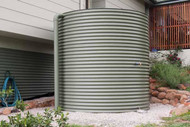The Importance of Having a Rainwater Tank at Home
1st Jun 2019
The importance of having a rainwater tank at home…
Most people install a rainwater tank primarily to harvest stormwater from their roof and conserve their mains water use. In addition to conserving water, a rainwater tank also helps treat stormwater and protect local streams from high storm flows by reducing the volume of stormwater and quantity of pollutants coming from a house block that would otherwise be delivered to the local stream.
What can I use my rainwater tank water for?
Garden irrigation, laundry and toilet flushing consume much of our home water use. In most cases these uses do not require the water to be of drinking quality standard that is provided by mains water. By plumbing your rainwater tank to your toilet or laundry and substituting these mains water needs with the rainwater harvested from your roof, you can conserve mains water whilst reducing the amount of stormwater that enters our streams.
Why can’t I use my rainwater tank for my garden alone?
So that your tank is not too full to collect rainwater when it rains, you need to be consistently using your tank water all year round.
If tank water is used for your garden alone, your tank will remain full and unused during the winter months when your garden does not require watering. With a full tank, your capacity to capture and store the regular winter rainfall and thus benefit the local waterway is significantly reduced.
By plumbing your rainwater tank to your toilet or laundry, your tank water is used consistently all year round allowing rainfall to refill the tank more often especially in winter. This ultimately reduces the volume of stormwater that is delivered to the stream and the quantity of pollutants that are washed with it.
How do I choose a rainwater tank?
The most important thing to consider when choosing a rainwater tank is to first identify what you want from your rainwater tank. The size and type of rainwater tank you choose will vary depending on your homes water needs and the reliability you seek from your rainwater tank supply. There are a number of factors that may influence this and the following questions should be considered when planning your tank installation:
- what is the water demand of your home?
- how many people are living in your home?
- what is your intended use of rainwater?
- what reliability do you want from your tank?
- what is the total area of roof draining into your tank?
- what is average rainfall of your area?
- do you need extras like a pressure pump, the ability to top up your tank with drinking water, a backflow prevention device or a first flush device?
- are the materials used on your roof suitable to collect rainwater?
- are there physical constraints of your property that may influence the type of rainwater tank you need?
Once you know how much water you can collect and how much water you are going to use then a tank size can be selected to provide the reliability of water supply that you need.
Types of rainwater tanks
Rainwater tanks come in a variety of materials, shapes and sizes and can be incorporated into building design so they don’t impact on the aesthetics of the development. They can be located above ground, underground, under the house or can even be incorporated into fences or walls.
There are three main tank systems to consider and a variety of materials to choose from. Features of these are outlined below and in the pictures above:
Tank systems:
Gravity Systems - rely on gravity to supply rainwater to the household and the garden by placing the tank on a stand at height.
Dual Supply Systems - top your rainwater tank with mains water when tank level is low ensuring reliable water supply.
Pressure Systems - use a water pump to deliver rainwater to household and garden fixtures.
To reduce the amount of sediment and debris entering a tank, mesh screens and ‘first flush diverters’ can be fitted. A screen will filter large debris such as leaves and sticks while ‘first flush diverters’ store the ‘first flush’ of the rainfall that carries the sediment and other pollutants initially washed from your roof
Approx Costs & Rebates
Costs of installing a tank vary however a standard 2000Lt tank or bladder will cost around $1000.
Additional plumbing and/ or.....
- Above ground tanks cost approximately $250 for a 500 litre tank.
- Below ground tanks cost between $300-$600 per 1000 litres of
storage
- The costs of pumps start from around $200.
Additional plumbing and/or excavation costs vary on intended use, pipe layout, materials and site accessibility.Most local governments offer a rebate for the installation of a rainwater tank that is plumbed to toilet and connected by a licensed plumber.



